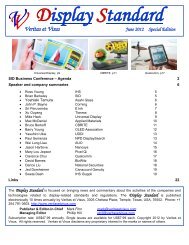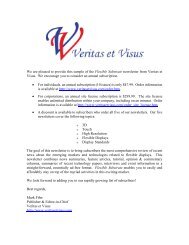Create successful ePaper yourself
Turn your PDF publications into a flip-book with our unique Google optimized e-Paper software.
<strong>Veritas</strong> <strong>et</strong> <strong>Visus</strong> <strong>Display</strong> <strong>Standard</strong> February 2009<br />
definitely not be restricted or monitored is the flame r<strong>et</strong>ardant t<strong>et</strong>rabromobisphenol (TBBPA), which a recent study<br />
conducted under the REACH remit found to be safe to humans and the environment. However, four substances<br />
have been identified for priority assessment and possible ban: hexabromocyclododecane (HBCDD), bis (2<strong>et</strong>hylhexyl)<br />
phthalate (DEHP), butyl benzyl phthalate (BBP), and dibutyl phthalate (DBP). Further afield, the<br />
much-delayed China-RoHS lists of products and substances are finally expected in the next couple of months. For<br />
more information regarding the proposed EU RoHS revisions, visit http://www.ipc.org/rohsrevisions.<br />
The WEEE and Batteries Directives may cause problems for those nations, particularly the UK, that have been slow<br />
to wake up to their implications; but it will be local authorities rather than the industry who will be suffering<br />
headaches this time round. On a more positive note, the missed opportunity of fully incorporating the Basel<br />
Convention into the WEEE Directive will be rectified under the EU Waste Shipment Regulation (EWSR). Another<br />
addition to WEEE that could arrive this year are new measures to make recycling safer and easier for consumers<br />
and businesses, but this may depend on how much progress is made with the other directives.<br />
The saga that has been the development and implementation of REACH looks s<strong>et</strong> to continue, but at the moment<br />
the major arguments are centering around chemicals used in agriculture. So whilst it is never a good idea to forg<strong>et</strong><br />
about the directive that has been dubbed “RoHS on steroids” it is more likely to be RoHS itself that will make the<br />
headlines. If there are problems, and if REACH’s history is anything to go by then there will be, they will almost<br />
certainly revolve around the “substances of very high concern” (SVHCs) listed under the Directive, of which there<br />
are 15 in use by the electronics industry with another seven likely to be added this year. Manufacturers will now be<br />
required to document and track any of these that constitute more than 0.1% by weight of a device, and as with<br />
RoHS there are no allowances for components sourced outside the EU for which this data is not available.<br />
Interestingly it may ultimately be consumers rather than policy-makers who will influence attitudes towards the<br />
directive, as consumer requests for information about SVHCs must be dealt with within 45 days. A few difficult<br />
questions could cause serious problems for careless manufacturers, and one is left wondering how a more policysavvy<br />
rival could exploit this to lever a comp<strong>et</strong>itive advantage.<br />
Finally there’s the Energy-using Products Directive. This is definitely the one to watch. The eco-design guidelines<br />
released last year were merely the app<strong>et</strong>izer before this year’s main course. EuP’s Implementing Measures for ecodesign<br />
will arrive this year to give the guidelines te<strong>et</strong>h. Whilst very little reliable information has so far come out of<br />
Brussels the expectation is that tungsten bulbs won’t be the only technology that EuP will phase out. The most<br />
inefficient power supply units are certain to be on this list, in line with the EU’s intention to revise its energy<br />
labelling scheme, and non-mercury-free CFLs may not be too far behind. Even this revision is causing controversy<br />
as it looks s<strong>et</strong> to result in a move away from the simple “A-G” rating to one consisting of numbers and l<strong>et</strong>ters.<br />
Earlier proposals looked at keeping the existing system but losing the lowest (G) category by banning all products<br />
in it from the mark<strong>et</strong>.<br />
This column has predicted the rise of EuP for some time now; this year we will finally learn how accurate those<br />
predictions were and this time next year it will be interesting to reflect the relative coverage generated by EuP<br />
compared to the more high profile revision of RoHS – but then where EU policy-making is concerned it is always<br />
safe to assume there will be a surprise or two along the way.<br />
One Laptop Per Child fights on<br />
Nicholas Negroponte’s One Laptop Per Child initiative has probably made more headlines for the s<strong>et</strong>backs it has<br />
suffered than the successes it has achieved, but OLPC has consolidated its operations and is now emerging healthier<br />
than ever. Negroponte, who is the founder and chairman emeritus of MIT’s Media Lab, founded OLPC with the<br />
aim of providing every child in the developing world with access to education through the provision of low cost<br />
laptops, with a targ<strong>et</strong> price of $100 a unit. The development of OLPC’s XO-1 machine hit a major obstacle back in<br />
2007 when chief technology officer, Mary Lou Jepsen refused to start a new company called Pixel Qi to support<br />
development of XO spin-offs separately. Then financial stresses led to further problems - the resignation of OLPC’s<br />
78






